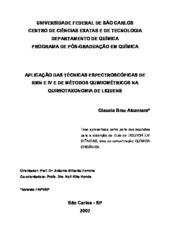Aplicação das técnicas espectroscópicas de RMN e IV e de métodos quimiométricos na quimiotaxonomia de liquens.
Abstract
This present work
describes the chemotaxonomic analysis of lichens through the utilization of NMR
spectroscopic techniques, HR-MAS and NMR in solution, and IR allied with
chemometrics methods. This analysis were carried out with eleven species set of
lichens divided in two families and six genera. The HR-MAS NMR spectra together
the chemometric, obtained from intact vegetal material, present the discrimination
between the families, genera and species and the classification percentage was
much satisfactory (70,8%). The analyzed substances include the carbohydrates class
of low molecular-weight, the polyols. The NMR in solution analysis, corresponding to
crude extracts, present the discrimination between genera and species and the
classification was excellent (88,9%). In this analysis, where the secondary
metabolites of lichens are evaluated, was realized the identification of some
substances in mixture. The analysis by infrared spectroscopy (IR), also obtained from
intact material, was detached by the excellent power of samples classification (100%
of correct prediction), with discrimination between genera and species. The
comparative application of this techniques confirm the results obtained separately,
and point for a great potentiality of IR in chemotaxonomic analysis of lichens, due its
quickness and low price, however the NMR techniques are more attractive when
desire the circumstantial analysis of spectral profile.
